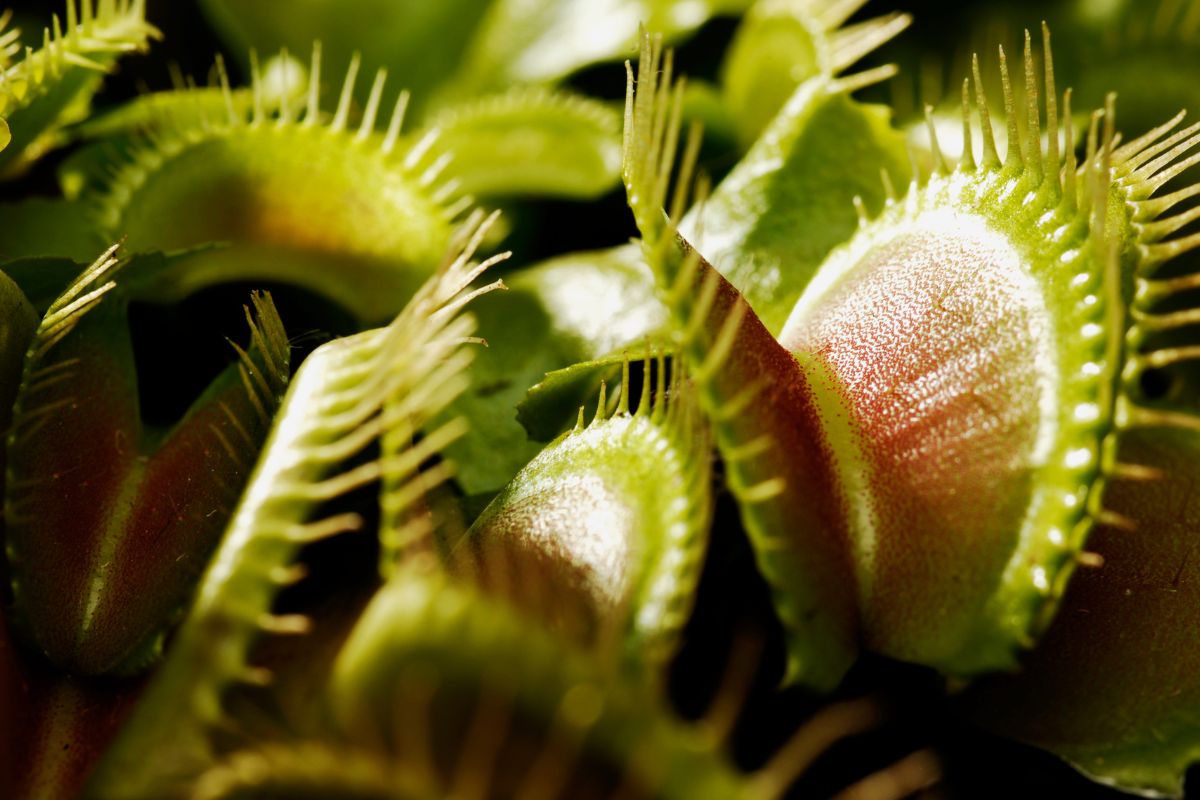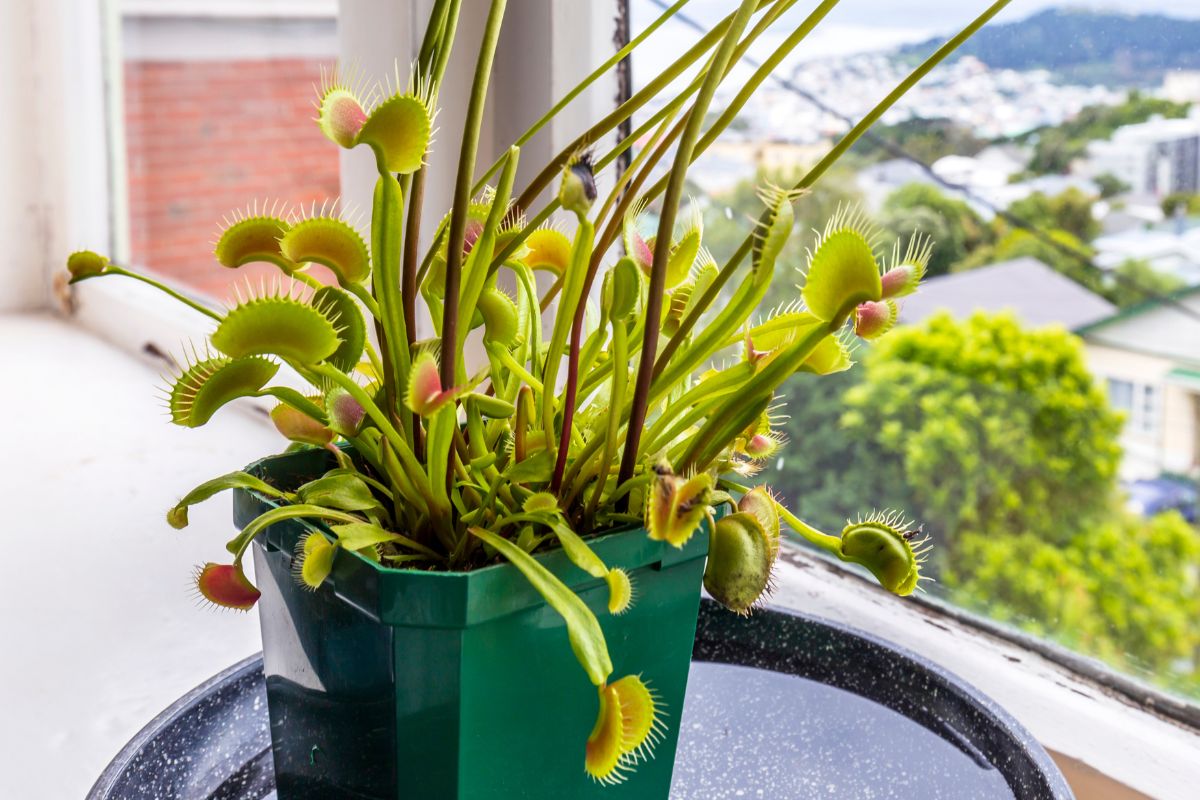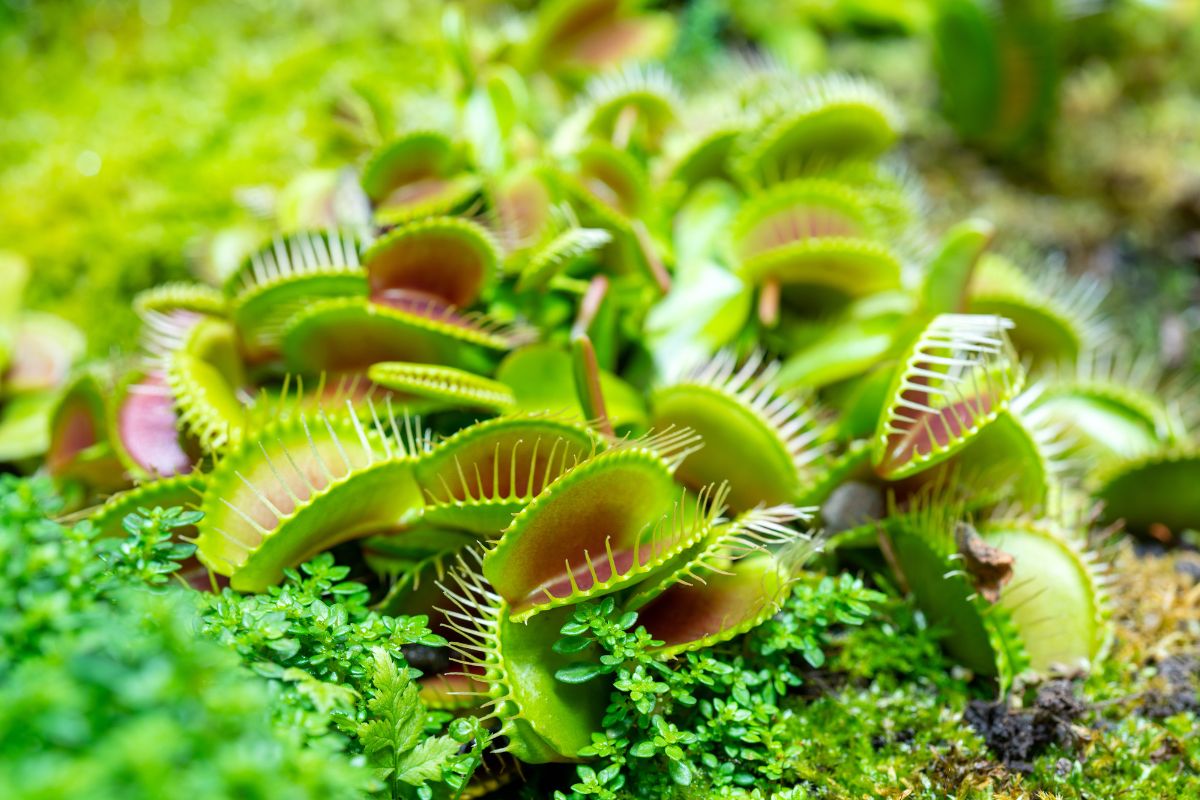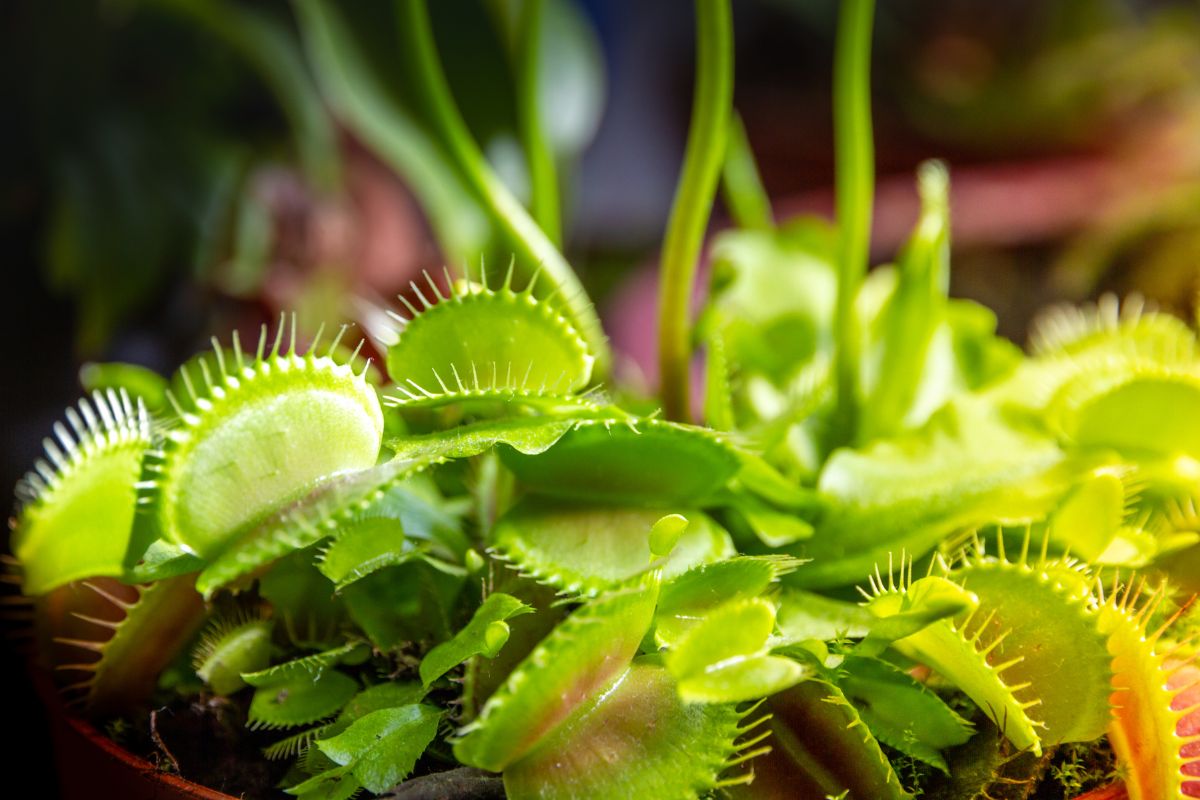Venus flytraps are carnivorous plants with sticky leaves that trap insects. They are also very sensitive to light levels.
This guide will help you understand Venus flytrap lighting requirements correctly.
This will include growing the plants indoors with a Venus Flytrap grow light and outdoors with natural lighting needs.
- Related article: Complete Guide to Venus Flytrap Care
What Are the Venus Flytrap Lighting Requirements?

To keep your Venus Flytrap in excellent health, proper lighting will be a priority when cultivating these plants. Follow these Venus fly trap
When your Venus Flytrap begins its growing season, these plants will need at least 12 hours of light daily and 4 of these hours per day should direct sunlight. Generous sunlight is essential to this plant’s overall well-being.
To meet these requirements indoors and outdoors, you’ll need to make slight adjustments to get the Venus Fly Traps the bright light they need.
Light Needed for Growing Venus Flytraps Outdoors
Ideally, Venus Flytraps should be cultivated outdoors for several reasons, not least of which is the availability of prey for capture.
Another important benefit to outdoor cultivation is exposure to UV rays that will kill mold spores and fungus, typically associated with damp environments. Outdoor rain and wind will also move fungi far from the plant. These important advantages are not available with indoor cultivation.
When deciding to cultivate your Venus Flytraps outdoors, select an area that guarantees they will receive sufficient light.
If, however, you reside in a sunny, arid climate with lots of heat, your plants should have access to shade, particularly at midday when direct light is at its most intense. This will help prevent your Venus Flytraps from scorching or drying out. Shade cloth that offers between 30% and 50% is optimal for this purpose.
Another alternative is a tree that provides dappled light through its canopy of leaves. This will afford your plant some protection from an excessively intense sun, while still ensuring the light that the Venus Flytrap needs in dry and sun-intense regions.
An added plus for outdoor cultivation is that your plant will receive all the light it needs, but it will be able to capture prey as well for its nutritional boost.
Light Needed for Growing Venus Flytraps Indoors
If you prefer to cultivate your Venus Flytrap indoors, your plant needs to be in a position where it will receive at least 4 hours of direct sunlight daily. Windows that face the east, west, or south are all suitable, with a south-facing window being the best choice.
- Learn more about Windows and Sunlight.
As long as your Venus Flytrap gets those 4 hours of direct sunlight exposition, it should thrive. And of course, you will need to feed prey to your Venus Flytrap every 2 to 4 weeks to provide nutritional support.
If your plant arrives from an indoor nursery or store, it may have received less than adequate lighting there. You should not abruptly position it to receive more sunlight once you bring it home. Your plant must be “hardened” before being able to receive 4 hours of sunlight in a single day.
Introduce your plant to direct sunlight gradually, for approximately an hour per day, but no more. After several days, increase light exposure to 2 hours a day and so on until you reach the minimum of 4 hours of sunlight daily.
If you attempt to skip the hardening phase, you risk scorching your plant’s leaves, which will subsequently die and turn black. Once the foliage has died, new growth will sprout, and the new leaves will be completely hardened and ready for their daily exposure to a sunny window.
Should you live in a home that does not benefit from direct sunlight exposure, your best alternative is to use artificial lighting to compensate for the lack of natural light. There are many grow lights that can provide supplemental lighting for indoor growing.
You can use grow lights in the growing season, and then move your plant to another spot with the proper cool temperature (32°-45°F.) during the Winter dormancy period.
Venus Flytraps need an annual dormancy period. If you keep them under intense artificial lighting year-round and do not allow for the dormancy period, your plant will eventually weaken because it hasn’t had time to rest.
Sunlight vs Grow Lights for Venus Flytraps

While technology has made incredible advances to the point that grow lights are a decent substitute in the event of low-light conditions or darkness, but the sun is more powerful. A plant must stay under a grow light for approximately 13 hours to receive the same benefits as 6 hours of real sunlight.
Without light, plants do not have sufficient energy to grow. Sunlight produces the full spectrum of colors necessary for your Venus Flytrap not only to survive but to thrive.
The full spectrum of lights includes red, blue, green, orange, indigo, violet, and yellow. But red and blue wavelengths are needed most for chemical energy conversion.
Plants need the blue spectrum of light for foliage growth. They need the red spectrum of light for buds, flowering, and berries -reproduction. Full-spectrum grow lights are practically on a par with the sun, but not quite.
Sunlight is also free. LED lights are energy efficient, but they still incur electricity costs and the initial price of purchasing the fluorescent lights. The sun gets the nod when it comes to the price.
Both the sun and grow lights have pros and cons. Much will depend on the cultivation environment.
Grow lights for your Venus Flytrap are a great option in these situations:
- You don’t have a suitable place outdoors to cultivate your plant.
- Your living space or office does not have natural light exposure.
- You have windows, but they heavily filter out the sun or are blocked by a building, a tree, or similar.
- Windows excessively magnify the amount of light and heat entering through them.
Grow lights will allow you flexibility:
- You can adjust the intensity of a grow light to provide sufficient light.
- You can adjust the position and direction of the grow light to meet space needs.
- You can achieve consistent light production for the entire growing season.
Benefits of Using Grow Lights for Venus Flytraps

The primary reason for using a grow light is that you do not have access to natural sunlight for a minimum of 4 hours daily in the location where you are cultivating your plant.
The use of a grow light will ensure that your Venus Flytrap receives the daily need of light required to keep your plant healthy and capable of photosynthesis for nourishment.
These grow lights attempt to replicate the light spectrum of natural sunlight, and they mimic the outdoor conditions by varying color, spectral output, and temperatures directly from the light.
Light-emitting diodes or LED lights produce the highest PAR (photosynthetically active radiation) of any light available and produce a spectrum of blue, red, and green wavelengths.
Venus Flytrap grow lights provide a number of benefits:
- Offer an alternative source of full-spectrum or white light that plants need to survive in a location without sunlight. The wide spectrum stimulates new growth.
- Are ECO-friendly. This kind of light can be completely recycled.
- Consume little energy.
- Offer a regulated plant environment, reducing pest and disease development.
- Can be adjusted to the desired heat while maintaining your Flytrap’s light wavelength requirements, so your plant is not at risk of suffering from burning.
- Can be placed closer to your plants because they emit less heat.
- Are durable, often lasting ten years or longer.
- Are flexible in their design, allowing you to attempt alternative lighting setups to better satisfy your Venus Flytrap’s light needs.
Best Grow Light for Venus Fly Trap
A Venus flytrap needs a minimum of 4 hours of sunlight per day to survive. In the growing season, the optimal sunlight hours increase to about 10 hours.
If you’re planning to grow your Venus flytrap indoors, a grow light becomes essential. You’ll want to keep your plant under the grow light for a majority of the time, ideally for 12-15 hours during the growing season.
LEDs are often the best choice for grow lights. They’re energy-efficient, cost-effective, and mimic the natural white light of the sun. Unlike traditional light bulbs, they produce light more efficiently, do not emit UV rays, and generate no heat.
They’re also eco-friendly, safe for people and pets, and are 100% recyclable. LED grow lights provide a full-spectrum light, similar to sunlight, which is ideal for plant growth.
What Color Grow Light for Venus Fly Traps are Great

When it comes to the color of a grow light for Venus fly traps, the best choice is a full-spectrum light. Full-spectrum lights provide a balance of cool and warm light that replicates the natural solar spectrum. They’re beneficial for plants because they cover all phases of plant growth.
Most full-spectrum lights will appear white to the human eye, but they provide all the colors of the spectrum, from blue to red. Blue light typically promotes leafy growth, while red light encourages blooming and fruiting. For Venus Flytraps, which are primarily leafy plants, a good balance of blue and red light is ideal.
LED grow lights are often a great choice for full-spectrum lighting. They’re energy-efficient, long-lasting, and can provide the balanced light that Venus Flytraps need to thrive.
LED lights also run cooler than other types of lights, which is important since Venus Flytraps don’t do well in high heat.
Factors to Consider When Installing Artificial LED Lights
LED lights are among the best lighting options if you need to cultivate your plant with artificial light. The possibilities for setting them up are endless.
You can limit your use to the functionality of the light or be decorative and achieve style as well.
Consider these aspects when choosing artificial lights to buy and install your LED lights:
- How many light bulbs will you need?
- Do you prefer longer grow lights or LED strips?
- What wattage should LED bulbs have? Most plants can do well with 30W per square foot.
- Choose or design your light rack or mount for easy adjustment.
- LED grow lights must be installed with a timer as you will not be leaving them on 24/7. This way you don’t forget to turn them on or off.
- Determine how long you should leave lights on daily. Most plants require at least 6 hours of darkness, so that’s up to 18 hours of LED lighting.
- Make sure the light rack height can be adjusted if you want to make changes. If the wattage is higher, the bulb can be positioned further away from the top of plants. LEDs can generally be placed 12 to 24 inches from your plant.
Venus Flytrap Grow Light Final Thoughts
All in all, there are several factors to consider when choosing a Venus fly trap grow light. Some people like the look of traditional fluorescent bulbs, but most of us would agree that LED lights offer a superior option. They are efficient, reliable, and eco-friendly.
For more on Venus Flytraps, check out these articles:



